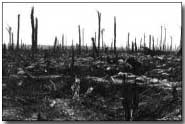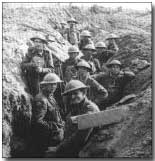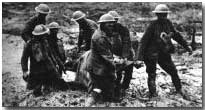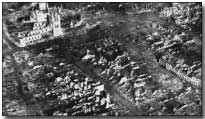Battles - The Third Battle of Ypres, 1917
 Whereas the
first and
second battles of Ypres were
launched by the Germans in 1914 and 1915 respectively, Third Ypres was
intended as Sir Douglas Haig's Allied forces breakthrough in Flanders in
1917.
Whereas the
first and
second battles of Ypres were
launched by the Germans in 1914 and 1915 respectively, Third Ypres was
intended as Sir Douglas Haig's Allied forces breakthrough in Flanders in
1917.
Haig had long mulled the idea of launching a major offensive in Flanders. It was his preferred choice for 1916, although in the event the Battle of the Somme took precedence that summer.
Meticulously planned, Third Ypres was launched on 31 July 1917 and continued until the fall of Passchendaele village on 6 November. The offensive resulted in gains for the Allies but was by no means the breakthrough Haig intended, and such gains as were made came at great cost in human terms.
Today commonly referred to simply as ‘Passchendaele', the tactics employed at the Third Battle of Ypres are as controversial as those executed at the Battle of the Somme a little over a year earlier, and was the final great battle of attrition of the war.
 Once
the French Nivelle Offensive had ended in disastrous failure in May, with
mutiny spreading throughout the French army, Haig determined to press ahead
with plans for a major British offensive in late summer.
Once
the French Nivelle Offensive had ended in disastrous failure in May, with
mutiny spreading throughout the French army, Haig determined to press ahead
with plans for a major British offensive in late summer.
The ostensible aim of the campaign was to be the destruction of German submarine bases on the Belgian coast, following a warning issued by British Admiral Jellicoe that the current level of shipping losses would prevent the British from sustaining the war into 1918, thus requiring clearance of the bases on the Belgian coast.
Haig, whilst recognising the urgency of this requirement, was at least as interested in finally breaking the will of the German army, which he believed was near to collapse - a faulty view that he similarly held at the height of the Somme offensive a year earlier.
British Prime Minister David Lloyd George was opposed to the Passchendaele offensive, and later came out highly critical of Haig's strategy and tactics in his published memoirs, but in the absence of a credible alternative to Haig he felt obliged to sanction Haig's plans.
He was however encouraged by arguably the greatest local success of the war earlier that summer, on 7 June, at Messines Ridge, when the Battle of Messines resulted in the complete capture of the Messines-Wytschaete ridge under General Plumer. The capture of the ridge was a necessary precursor to an offensive aimed at capturing Passchendaele ridge.
Plumer advocated continuing the attack immediately into Passchendaele ridge, arguing that the morale of the German troops was, for the present at least, broken, and that this combined with a shortage of forces would virtually guarantee Allied capture of the ridge. Haig however disagreed, choosing not to bring forward his plans from the end of July.
 With the patent instability of Russian forces in the
field, and the possibility of a Russian withdrawal from the war, action
certainly appeared to be mandated in the summer of 1917. Were the Russians
to leave the war it would enable Germany to draft its Eastern forces into
the battle on the Western Front, dramatically increasing German reserve
strength.
With the patent instability of Russian forces in the
field, and the possibility of a Russian withdrawal from the war, action
certainly appeared to be mandated in the summer of 1917. Were the Russians
to leave the war it would enable Germany to draft its Eastern forces into
the battle on the Western Front, dramatically increasing German reserve
strength.
The Third Battle of Ypres was opened by Sir Hubert Gough's Fifth Army, with 1 Corps of Sir Herbert Plumer's Second Army joining on its right and a corps of the French First Amy led by Anthoine to its left: a total of twelve divisions.
As was the norm for any major Allied offensive, on 18 July a heavy preliminary artillery bombardment was effected for the ten days prior to the launch of the attack at 03:50 on 31 July. The bombardment made use of 3,000 guns which expended four and a quarter million shells. Given such an onslaught the German Fourth Army, led by Arnim, fully expected an imminent offensive: the element of surprise was entirely absent.
Thus when the attack was launched across an 18 kilometre front, Fourth Army was in place to hold off the main British advance around the Menin Road, and restricted the Allies to fairly small gains to the left of the line around Pilckem Ridge. Similarly the French were halted further north by the German Fifth Army under Gallwitz.
 British attempts to renew the offensive over the course
of the next few days were severely hampered by the onset of heavy rains, the
heaviest in 30 years, which churned the Flanders lowland soil into a thick
muddy swamp.
Tanks found themselves immobile, stuck fast in the mud.
Similarly the infantry found their mobility severely limited. Ironically
the very force of the preliminary bombardment had itself destroyed drainage
systems, exacerbating the problem. In addition, the artillery shells that
had rained down in the days prior to the attack's launch had peppered the
very ground that needed to be traversed by the advancing Allied forces.
British attempts to renew the offensive over the course
of the next few days were severely hampered by the onset of heavy rains, the
heaviest in 30 years, which churned the Flanders lowland soil into a thick
muddy swamp.
Tanks found themselves immobile, stuck fast in the mud.
Similarly the infantry found their mobility severely limited. Ironically
the very force of the preliminary bombardment had itself destroyed drainage
systems, exacerbating the problem. In addition, the artillery shells that
had rained down in the days prior to the attack's launch had peppered the
very ground that needed to be traversed by the advancing Allied forces.
As a consequence no renewed major offensive could be contemplated until 16 August, when the Battle of Langemarck saw four days of fierce fighting which resulted in small gains for the British, but heavy casualties.
Dissatisfied with progress the British Commander-in-Chief, Haig, replaced Sir Hubert Gough (by moving him and his forces further north) with Herbert Plumer. Whereas Gough favoured sweeping aggression, Plumer planned a series of small gains rather than an all-out breakthrough. The attacks began afresh on 20 September with the Battle of the Menin Road Bridge. This was followed by the Battle of Polygon Wood on 26 September and the Battle of Broodseinde on 4 October. Taken together these established British possession of the ridge east of Ypres.
Encouraged by Plumer's small gains - while constantly pushing him to do more - Haig decided to continue the offensive towards Passchendaele Ridge some ten kilometres from Ypres, by now certain that the German army was approaching collapse.
 Little progress towards this end was made at the Battle
of Poelcappelle and the First Battle of Passchendaele, on 9 October and 12
October respectively.
Little progress towards this end was made at the Battle
of Poelcappelle and the First Battle of Passchendaele, on 9 October and 12
October respectively.
The Allied attackers were themselves nearing exhaustion as German reserves released from the Eastern Front were poured into the ridge. To aid in their defence the Germans made full use of mustard gas (as opposed to chlorine gas in The Second Battle of Ypres), which resulted in chemical burns.
Unwilling to concede the failure of the breakthrough, Haig pressed on with a further three assaults on the ridge in late October. The eventual capture of Passchendaele village by British and Canadian forces on 6 November finally gave Haig an excuse to call off the offensive claiming success.
The Third Battle of Ypres was, like its predecessors, a costly exercise. The British Expeditionary Force (BEF) incurred some 310,000 casualties, with a similar, lower, number of German casualties: 260,000. The salient had been re-widened by several kilometres.
Haig came under intense criticism both in 1917, and since, for persisting with the offensive after it became clear that a breakthrough was unlikely. Critics have argued that the main launch pad for the attack should have been sited at Messines Ridge, captured by Plumer in June; but Haig's original plans precluded this, viewing the capture of the ridge as a necessary diversion, and he declined to modify his plans: evidence, some say, of an inflexible strategy.
 However, numerous factors are cited to support the
decision taken to continue the offensive into the autumn. With the Russian
withdrawal from the war, British vulnerability to submarine attacks launched
from the Belgian coast, and weakened French morale which manifested itself
in widespread mutiny, it seemed clear that a decisive strike must be
attempted before the Allied war effort collapsed.
However, numerous factors are cited to support the
decision taken to continue the offensive into the autumn. With the Russian
withdrawal from the war, British vulnerability to submarine attacks launched
from the Belgian coast, and weakened French morale which manifested itself
in widespread mutiny, it seemed clear that a decisive strike must be
attempted before the Allied war effort collapsed.
It is further argued that the disastrous turn in the climate could not have been predicted: that the rainfall was by far the heaviest for many years. Indeed, fighting had taken place around Ypres since 1914 without the kind of problems experienced during Third Ypres.
Haig himself argued that when regarded as a battle of attrition, the German forces could less afford the loss of men than the Allies, who by this time were being supplemented by the entry into the war of the U.S. This view is shared by a number of German contemporaries.
Needless to say, the controversy continues today; however most historians continue to question Haig's decision not to call off the offensive earlier than November, when at least a number of the core objectives had been attained, and it became clear that the French forces would remain in the field.
Click here to view a map charting the progress of the battle.
Photographs courtesy of Photos of the Great War website
Sir John Davidson on British tactics at Ypres
Sir David Watson on the Canadian effort
Erich Ludendorff's account of German losses at Third Ypres
Memoirs - Artillery Devastation at Third Ypres
Memoirs - A Labour Company at Ypres
Memoirs - A July Day at St. Julien
The Western Front Today: Menin Gate
The Western Front Today: Ypres Cloth Hall
The Western Front Today: Tyne Cot, Passchendaele
The Western Front Today: New British Passchendaele Cemetery
'Strafing' is attacking ground troops by machine guns fired from low-flying aircraft.
- Did you know?
